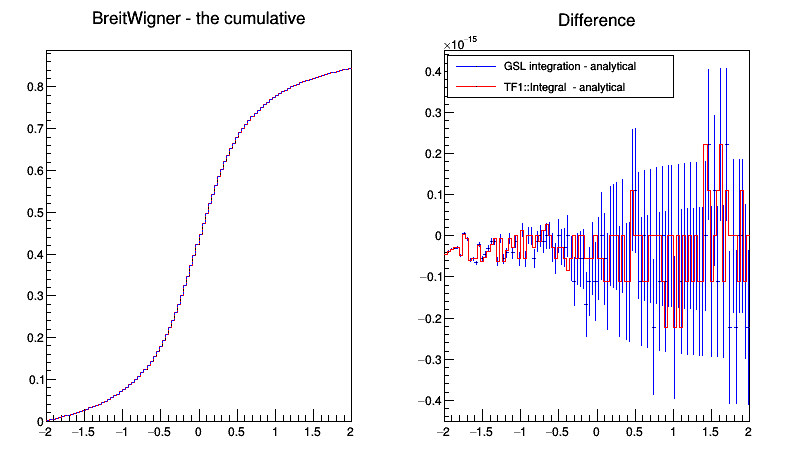Example on the usage of the adaptive 1D integration algorithm of MathMore it calculates the numerically cumulative integral of a distribution (like in this case the BreitWigner) to execute the macro type it (you need to compile with AClic)
More...
Example on the usage of the adaptive 1D integration algorithm of MathMore it calculates the numerically cumulative integral of a distribution (like in this case the BreitWigner) to execute the macro type it (you need to compile with AClic)
root[0] .x mathmoreIntegration.C+
This tutorials require having libMathMore built with ROOT.
To build mathmore you need to have a version of GSL >= 1.8 installed in your system The ROOT configure will automatically find GSL if the script gsl-config (from GSL) is in your PATH,. otherwise you need to configure root with the options –gsl-incdir and –gsl-libdir.

#include <iostream>
#include <limits>
int nc = 0;
}
nc++;
}
double func2(const double *x, const double * = 0){
nc++;
}
std::cout << "\n\n***************************************************************\n";
std::cout << "Test integration performances in interval [ " << x1 << " , " << x2 << " ]\n\n";
double dx = (x2-
x1)/
double(n);
double s1 = 0.0;
nc = 0;
for (
int i = 0; i <
n; ++i) {
double x = x1 + dx*i;
s1+= ig.Integral(x1,x);
}
std::cout <<
"Time using ROOT::Math::Integrator :\t" << timer.
RealTime() << std::endl;
std::cout << "Number of function calls = " << nc/n << std::endl;
int pr = std::cout.precision(18); std::cout << s1 << std::endl; std::cout.precision(pr);
TF1 *fBW =
new TF1(
"fBW",func2,x1, x2,0);
nc = 0;
double s2 = 0;
for (
int i = 0; i <
n; ++i) {
double x = x1 + dx*i;
}
std::cout <<
"Time using TF1::Integral :\t\t\t" << timer.
RealTime() << std::endl;
std::cout << "Number of function calls = " << nc/n << std::endl;
pr = std::cout.precision(18); std::cout << s1 << std::endl; std::cout.precision(pr);
}
void DrawCumulative(double x1, double x2, int n = 100){
std::cout << "\n\n***************************************************************\n";
std::cout << "Drawing cumulatives of BreitWigner in interval [ " << x1 << " , " << x2 << " ]\n\n";
double dx = (x2-
x1)/
double(n);
TH1D *cum0 =
new TH1D(
"cum0",
"", n, x1, x2);
for (
int i = 1; i <=
n; ++i) {
double x = x1 + dx*i;
}
TH1D *cum1 =
new TH1D(
"cum1",
"", n, x1, x2);
for (
int i = 1; i <=
n; ++i) {
double x = x1 + dx*i;
}
TF1 *fBW =
new TF1(
"fBW",
"TMath::BreitWigner(x, 0, 1)",x1, x2);
TH1D *cum2 =
new TH1D(
"cum2",
"", n, x1, x2);
for (
int i = 1; i <=
n; ++i) {
double x = x1 + dx*i;
}
TH1D *cum10 =
new TH1D(
"cum10",
"", n, x1, x2);
TH1D *cum20 =
new TH1D(
"cum23",
"", n, x1, x2);
for (
int i = 1; i <=
n; ++i) {
}
cum0->
SetTitle(
"BreitWigner - the cumulative");
l->
AddEntry(cum10,
"GSL integration - analytical ");
l->
AddEntry(cum20,
"TF1::Integral - analytical ");
std::cout << "\n***************************************************************\n";
}
void mathmoreIntegration(double a = -2, double b = 2)
{
#if defined(__CINT__) && !defined(__MAKECINT__)
cout << "WARNING: This tutorial can run only using ACliC, you must run it by doing: " << endl;
cout << "\t .x $ROOTSYS/tutorials/math/mathmoreIntegration.C+" << endl;
return;
#endif
DrawCumulative(a, b);
}
- Authors
- M. Slawinska, L. Moneta
Definition in file mathmoreIntegration.C.


